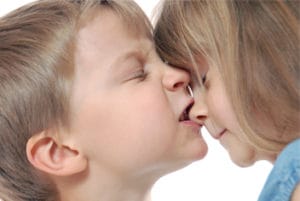What toddler biting means for parents
This article originally appeared in the April issue of Raising Arizona Kids Magazine.
By Dr. Alison Steier, Southwest Human Development’s director of mental health services
Toddlers are passionate beings. They feel their emotions intensely and can show them in very dramatic ways without embarrassment. While we admire toddler’s unrestrained joy and affection, their capacity to feel and express “negative” emotions, such as sadness and anger, can be challenging.
 A toddler’s ability to process negative emotions are an important key to healthy development, but can manifest into unwanted behavior, like biting.
A toddler’s ability to process negative emotions are an important key to healthy development, but can manifest into unwanted behavior, like biting.
Parents often worry that bitten playmates or other parents may reject their child, and that biting is an early sign of bigger challenges to come. These scenarios lead to parents asking themselves, “how do I respond when my child bites?”
Take a breath and calm yourself. You are about to teach something important. An adult’s over-reaction can scare or shame a child, which is an unfavorable method to learn about the self. A dramatic reaction may cause the child to nervously smile or laugh because of the adult’s big reaction, and can actually result in an increase in biting. Lead by example. Being upset is contagious; so is being calm.
Say to the child, “No biting. Biting hurts!” simply and firmly. Following a swift reprimand, parents can point out reactions cause by the act of biting. Bringing attention to reactions visually shows toddlers the cause of their action. E.g. “Katie is crying because your bite hurt her arm.”
Direct most of your attention to the individual who was bitten. Comfort and show understanding to the child, or adult, that was bitten. By responding to the bitten individual with empathy, you are modeling appropriate behavior that both children can learn from. Shift your focus from forcing the obligatory phrase “I’m sorry,” and instead strive to show your biting child the caring attention and sincere concern actions that follow another person’s difficult experience.
Wait until the dust settles after the biting incident to discuss biting with the child. Talk with the child who did the biting in a quiet, calm moment sometime after the biting scenario. Help label the feelings the child may have had when he or she bit. E.g. “I think it made you feel really, really mad when Katie took the ball you were playing with.” Give examples of alternatives to biting for the future.
Despite their zeal and energy, toddlers do not appreciate that “taking a bite out of life” is just an expression! It is our job as wiser, stronger and caring adults to teach young children about their personal feelings, the feelings of others and the range of expression of feelings that is acceptable within their relationships and culture.
For free child development support, call the Birth to Five Helpline at 877-705-KIDS (5437)
or download the Birth to Five Helpline app!
All content in this article, including any advice or commentary from Southwest Human Development staff and/or others, should be considered an opinion and is provided for informational purposes only. The content is not intended to be a substitute for medical or other professional advice, diagnosis or treatment. Always seek the direct advice of your own trusted professional with any questions or concerns you may have regarding the child/ren in your care. Southwest Human Development does not recommend or endorse any specific tests, products, procedures or other information that may be mentioned in this article. You may contact Southwest Human Development’s Birth to Five Helpline at 1-877-705-KIDS (5437) to speak with one of our early childhood professionals for personalized assistance. Birth to Five Helpline specialists are available Monday through Friday from 8 a.m. to 8 p.m.


